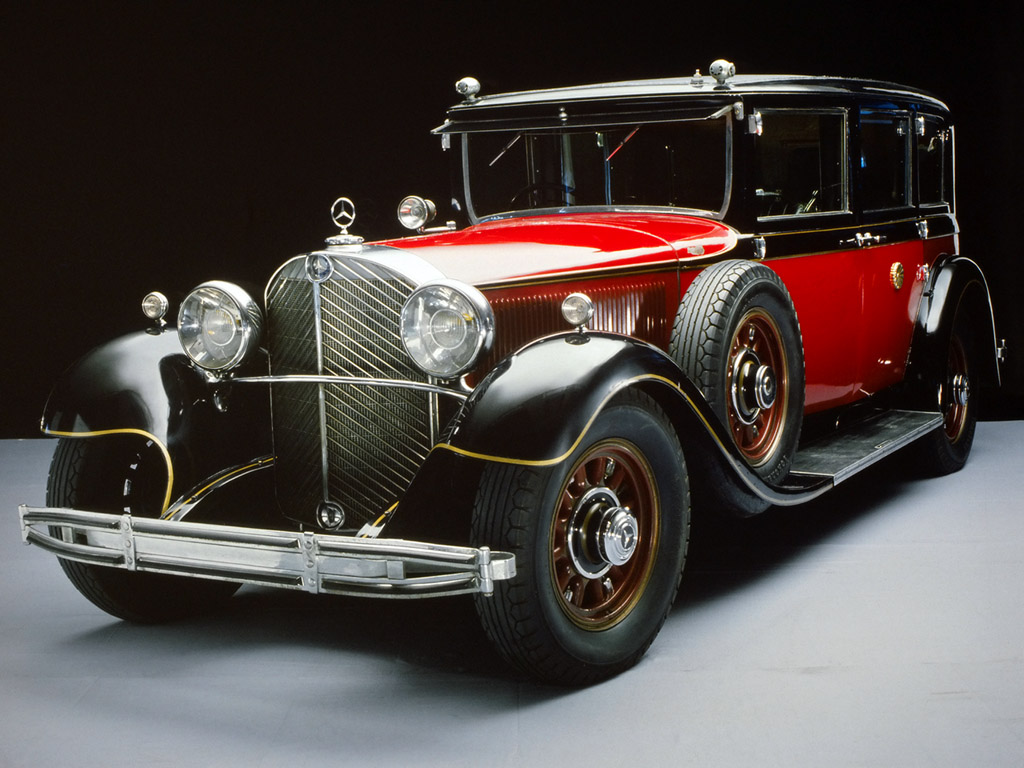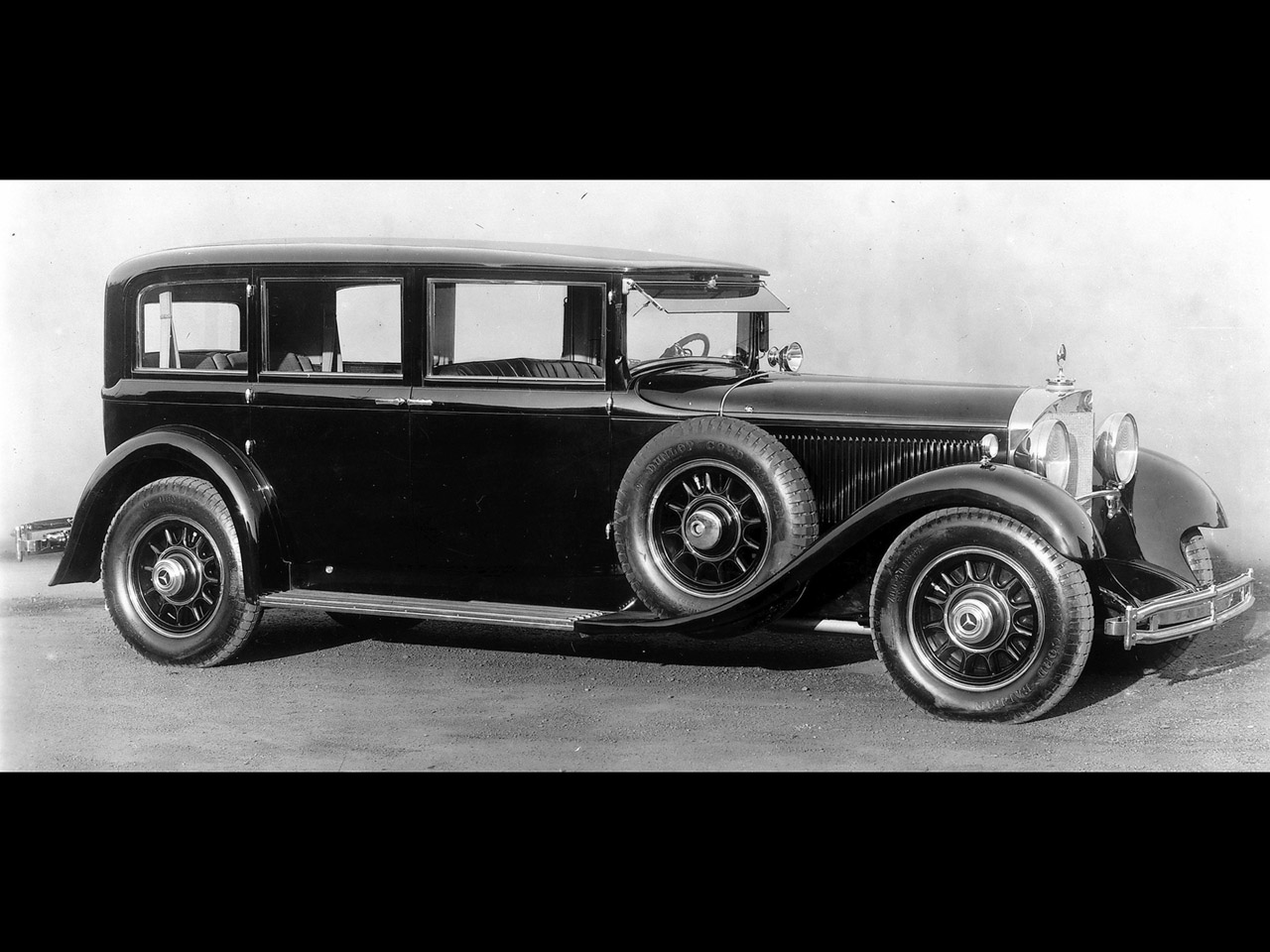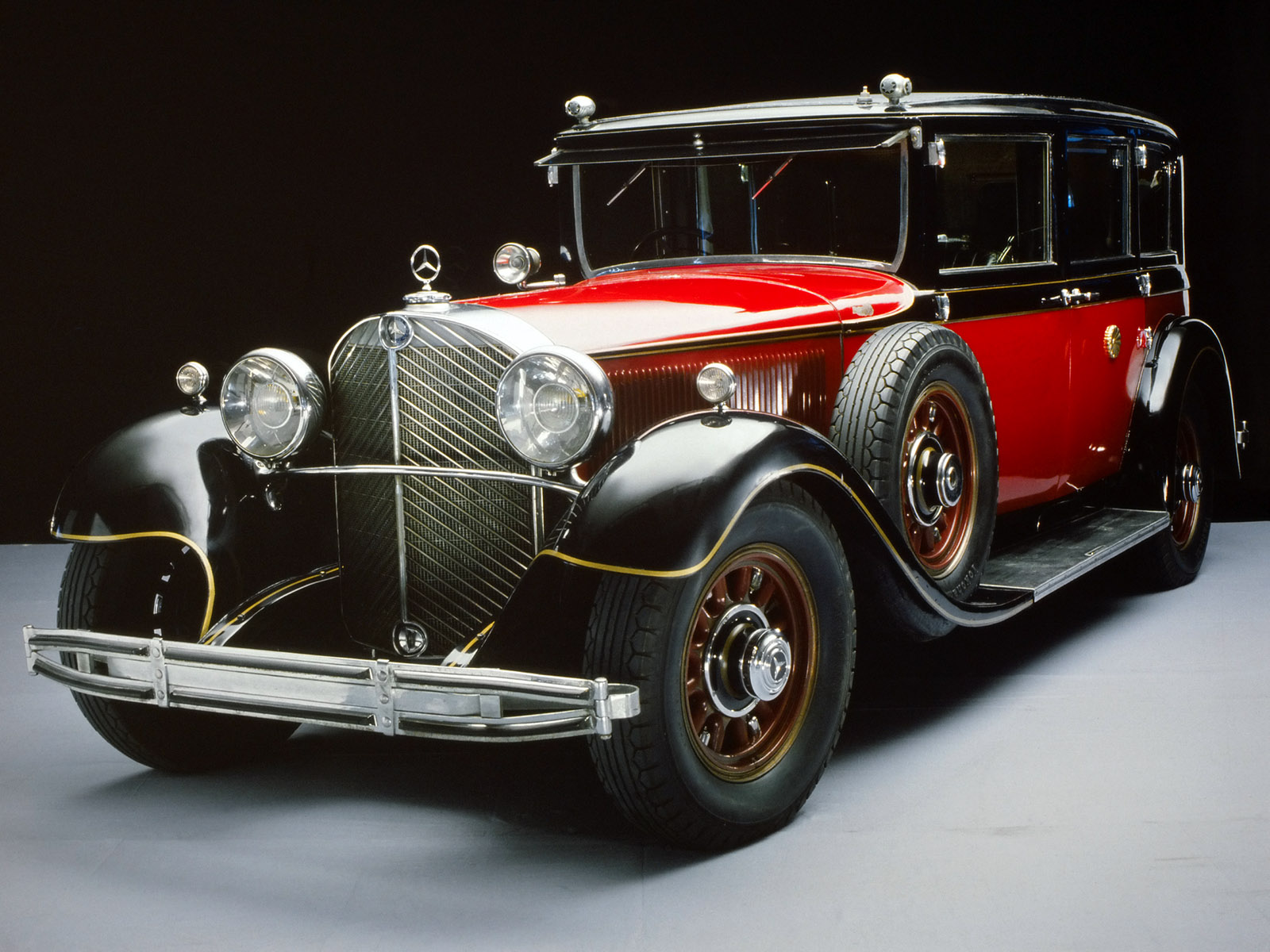Mercedes-Benz Type 770 Grand Mercedes
|
Price |
-- |
Production |
-- | ||
|
Engine |
7.7 liter inline 8 |
Weight |
-- | ||
|
Aspiration |
supercharger |
Torque |
395 lb-ft @ 1500 rpm (original) | ||
|
HP |
200 hp @ 2800 rpm (original) |
HP/Weight |
-- | ||
|
HP/Liter |
26 hp per liter |
1/4 mile |
-- | ||
|
0-62 mph |
-- |
Top Speed |
99 mph |
(from DaimlerChrysler Press Release) When the Mercedes-Benz Type 770 was presented at the Paris Automobile Show in the autumn of 1930, this “Grand Mercedes” far outstripped the familiar dimensions in the category of high-quality, high-performance luxury automobiles. Right off the bat, it set a new standard in the world of top-flight passenger cars for prospective customers, the public and the experts. Internally designated W 07, the car indeed was the largest and, in every respect, most luxurious Mercedes offered by Daimler-Benz to its customers, costing the price of a single-family home, but in return featuring an ultramodern 200 hp supercharged engine and a “Sindelfingen body” with sensational appointments and an exquisite finish.
7.7-liter in-line eight-cylinder with fine ingredients
The engine offered a number of exceptional features to a technically extremely well-versed clientele. The cylinder block of the voluminous (displacement 7655 cm3) in-line eight-cylinder engine, made of extremely wear-resistant chrome-nickel-alloyed gray cast iron, was combined with a heavily ribbed crankcase bottom half incorporating an integral oil pan made of electron metal. Carefully balanced statically and dynamically, the chrome-nickel steel crankshaft with solid-forged counterweights ran in nine main bearings and additionally had a progressively acting vibration damper at its front end to ensure even smoother and quieter running of the power plant, internally called the M 07.
It went without saying that such an engine could not have a simple side-valve configuration. The overhead valves in the gray iron cylinder head were actuated by means of roller tappets, push rods and rocker arms controlled by a side camshaft running in nine bearings.
Updraft dual-barrel carburetor, accelerator pump and cold-starting aid were the most important components of the energy supply system, supported by a light-alloy inlet manifold automatically heated by exhaust gas and thermostat controlled hot-air flaps. The ignition system also evidenced technical finesse. The combined battery-magneto ignition, whose two elements operated independent of each other, ensured reliable double ignition of the sparkplug sets recessed in the cylinder head on the left and right sides.
Power to spare with the “whispering” supercharger
The low-compression
(4.7:1) long-stroke engine developed 150 hp at a moderate 2800
revolutions; the high torque of 40 mkg was already available at 1200
rpm. That was easily enough to satisfy prestige requirements and
attain a top speed of 150 km/h. But it was still too little for a
power-hungry clientele.
Accordingly, a supercharger – for the price of a respectable
intermediate class car – was an available option. But the Roots
blower as high-pitched power booster in Mercedes sports cars was
quite out of place in a luxury car. Owing to very effective intake
noise damping, it mutated into a “whisperer” in the 770 with now
only a muted snorting sound.
For better heat dissipation – and as status symbol – the supercharger-equipped models were fitted with exhaust pipes sheathed in flexible metal hose projecting from the right-hand side of the hood. In the end, only a few customers actually bought the car without a supercharger.
With the aid of the supercharger, engine output rose to 200 hp at the same engine speed, torque increased to a dizzying 54.6 mkg at 1500 rpm, and the top speed to 160 kilometers per hour. That provided the kick that earned the Grand Mercedes the nickname “Road Express”.
Ride comfort and safety
Ball gear shift and helical spur gears were the special features of the three-speed gearbox installed in a light-alloy housing. It was complemented by an overdrive box to reduce engine speed at higher traveling speeds; this could be engaged in any gear, in effect giving the car six gears.
Power was transferred by a dry double-plate clutch to the pressed sheet-steel rigid banjo rear axle with cast differential case made of light alloy. The forged H-beam solid-end front axle made of chrome-nickel steel likewise was rigid. Both axles were attached by semi-elliptic springs to the semi-drop-frame, a pressed U-shaped sheet-steel construction.
Double-acting hydraulic lever-type dampers reduced road shock, and anti-shimmy blocks on the front spring shackles suppressed wheel wobble. A fully automatic central lubrication system supplied all lubrication points of the chassis, including the Cardan universal joint, with motor oil heated to operating temperature.
The helical spindle steering was said to have outstanding road feel, but was not exactly light. The car was equipped either with wood or wire spoke wheels as requested by the customer.
The high demands on
operating convenience and safety were met by the mechanically
actuated, generously dimensioned brakes, whose huge drums had
longitudinal ribs for cooling and the actuation of which was
facilitated by a vacuum servo unit. They decelerated the 2.7 ton car
quite effectively.
In the interaction of its parts, the entire chassis design gave the
Grand Mercedes an unusual ride comfort and a very high level of
handling safety for a car of that period.
The “Sindelfingen body”
Upon the introduction of the 770, the bodies built in Sindelfingen already had gained a certain amount of fame, as several of the Mercedes-Benz models, for instance the “Nürburg” type, had been delivered for some time “ex works Sindelfingen” complete with coachwork and ready-to-drive.
What was new, however, was that a car of the top luxury class now also could be delivered complete – in keeping with the spirit of the times, in the versions Pullman sedan, six-seater (open) touring car, four-door Cabriolet D and six-seater Cabriolet F, which all underscored the desired prestigious character of the Grand Mercedes. The Cabriolets B (four windows) and C (two windows), on the other hand, gave the long, low chassis of the 770 a more sporty touch.
The flawless workmanship of the bodies and their interior met with enthusiastic approval on account of the choice taste and excellently quality they embodied. The reputation of the “Sindelfingen body” and its agile creators was broadcast throughout the world.
As a matter of principle, the buyer of the 770 could influence the final execution, both of the exterior and the interior, to suit his taste. So it is not surprising that, to a large extent, each car bore the personal signature of its original owner.
Exterior with flowing lines
Characteristic of the Grand Mercedes was its face, with the vertical, slightly wedged chrome-plated honeycomb radiator, usually protected by a stone-deflecting herringbone-pattern grille set before it. Alongside the radiator, huge headlamps set on bows – an arrangement which can still be termed “classic” – threw far-reaching headlamp beams.
The imposing hood went over into coachwork which emphasized length with a comparatively low belt line; with the wheelbase of 3750 mm, in every version it afforded the occupants plenty of room, particularly considering that the width of 1840 mm was not stingy either.
The double bumpers made of spring steel had thick layers of rubber and effectively protected the 5600 mm long car against minor impact. The spare wheels were stored in recesses in the front fenders.
Even a reversing light was included.
In the course of two
updates to the bodies in 1934 and 1936, the hood received horizontal
ventilation slots to add still more emphasis to the long, flowing
lines, and the fenders, too, were more strongly cambered and got
softer lines, side aprons and harmonious transitions to the running
boards. The tank filler pipe disappeared behind a flap in the rear
fender. The bow for the lamp also was discarded, so that the
monumental and unchanged vertical radiator plowed through the air
even more impressively.
Depending on body type and customer wishes, the rear end featured a
luggage deck with box or even a proper trunk with elegant,
individually handmade cases.
Interior with consummate luxury
The opulent technical appointments “under the skin” had their counterpart in the instruments of the centrally arranged dashboard set in polished wood: speedometer with tops of 160 km/h, including trip and overall mileage recorder; rev counter, clock, remote cooling water thermometer, oil pressure gauge, fuel gauge and a combined ammeter and voltmeter. The horn was operated by the signal ring on the steering wheel, the hub of which conveniently incorporated the levers for mixture regulation, ignition timing and overdrive engagement.
The “air conditioning” was typical of those days. It was the hinged windshield, vertical in the first versions, but cautiously retouched in the years following, becoming increasingly raked, to achieve a more appealing streamline.
Almost as numerous as the number of cars built were the seating and upholstery versions: leather, velvet, but also exotic materials; colors to suit the customer. Ample polished wood applications, integral ashtrays, oddments boxes, built-in bar, driver intercom served for comfort, convenience, and as a feast for the eyes. And let’s not forget the powerful Autosuper radio with two loudspeakers each at the front and rear, unfortunately without stereo effect. A forced-air heater made for cozy warmth in the rear passenger compartment and additionally supported the electric windshield heater.
Individual luxury in the 770 was understood and gave it that special flair which the rich and powerful of all shades treasure, for which reason they were all too happy to make use of the Grand Mercedes. Daimler-Benz manufactured 119 units of the W 07 between September 1930 and June 1938: 42 Pullman sedans, 26 open touring cars, 18 Cabriolet D, 14 Cabriolet B, C and F and 19 chassis. The successor was already knocking on the door.
Avant-garde design in the evolutionary successor
In February 1938, at the IAMA International Motor Show in Berlin, the evolutionary stage of the Grand Mercedes was launched, internally designated W 150. Largely redesigned, the car, which continued to be called the Mercedes-Benz 770, manifested the art of automobile manufacture in perfection, the creativity of its engineers, and the inimitable avantgarde design work of Daimler-Benz.
Power plant and drive train in perfection
The power plant was unchanged as regards fundamental dimensions, but featured a number of modifications, as documented by the new engine code M 150.
The crankcase was now completely made of light alloy, the exhaust valves were sodium-cooled, ignition control was automatic, and the water pump was rigidly driven by the oil pump shaft. Three geared oil pumps quite effectively ensured forced-feed lubrication.
Even the engine was exquisitely finished. Cylinder block and accessories housings were enameled black; brass lines and the fan were chrome-plated; light-alloy elements featured a polished hammertone finish.
The supercharger, now standard, featured higher efficiency and was engaged with the accelerator pedal, as usual. In naturally aspirated mode, the engine, with a compression ratio of 6.1:1, now developed 155 hp, with supercharger 230 hp. Torque rose to 47 mkg at 1900 rpm and 56 mkg at 2000 rpm, respectively. The top speed was 170 km/h.The all-synchromesh four-speed gearbox was complemented by a remote gear, installed in the differential case, which could be additionally engaged at any speed. Inconvenient to use and unnecessary to boost performance, this configuration was replaced in 1939 by a five-speed gearbox whose fifth gear functioned as an overdrive. Power transfer was effected by a stronger single-plate disc clutch.
For special purposes, there was an engine with a compression ratio of 7.2:1, two double-barrel updraft carburetors and two superchargers. The power output: 160 hp in naturally aspirated mode, 400 hp with both superchargers engaged, in each case at 3600 rpm. Top speed ranged from 180 to 200 km/h.
However, only five cars with this variant were ever built.
Oval-tube frame, individual wheel suspension and hydraulic brakes
Entirely new were the frame and axles; the brakes had even better grip. The chassis side members, made of oval tube, were joined with six cylindrical cross members to make a very torsion-resistant ladder-type frame.
The now individually coil-sprung front wheels were located by A-frame arms arranged in a parallelogram. But the real surprise was the rear axle, a “double-joint axle”, as the trade literature termed it, designed according to the De Dion principle. Daimler-Benz themselves termed it a “laterally stable parallel-wheel axle.” It had constant camber and track and was complemented by a V-shaped anti-sway linkage connected by a rubber doughnut to the middle cross tube. To the next but last cross member, the three-point rubber-mounted differential was attached. Naturally, the rear axle also had coil springs; from 1939 on double coil springs, one inside the other.
The already highly effective brakes of the first 770 were adapted to the successor’s increased performance and up to 900 kilograms of additional weight; they were now hydraulically operated and continued to have vacuum servo assistance. Each wheel had two brake cylinders, each serving one of the self-adjusting primary brake shoes. The new sheet-steel disc wheels had center mounts.
Larger dimensions, lower overall height
The evolutionary 770 was stretched another 40 centimeters to six meters in length; its wheelbase was a proud 3880 mm, and the width, too, grew by 23 cm to a respectable 2.07 m. Following the fashion, the overall height was reduced by three centimeters: Hats and caps were not as tall as top hats. The wedge-shaped radiator was now slightly sloped. The standard bodies offered were the Pullman sedan with saloon partition, the open touring car, the Cabriolets D and F. Special wishes continued to be catered to, and all variants also could be supplied in armored versions. In that case the production code was then W 150 II, and the car weighed no less than 4800 kilograms; speed was limited to 80 km/h because of the bulletproof cell-type tires.
A total of 88 W 150’s rolled out of the Sindelfingen factory bay by mid 1943. They saw service partly up to the late 1960’s, and a number of specimens are still preserved today in museums and private collections.
The Grand Mercedes, especially in the king-size format of the evolution stage, pointed the way with its avant-garde engineering and, to this day, determines the form, safety, comfort, performance and elegance of particularly prestigious limousines. In its day it contributed decisively to further enhance the image of the Mercedes-Benz make all over the world.



